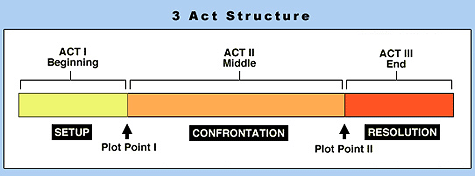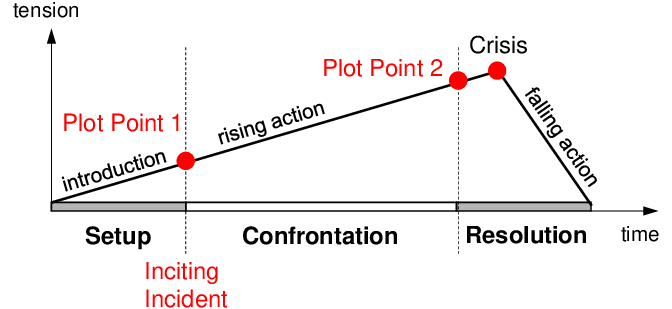The three act structure serves as a plan for building the story a screenwriter wishes to tell. No matter the creative heights a screenwriter may have attained in writing screenplays, the screenwriter wouldn’t be able to alter the basic structure of storytelling, which says that a story must have a beginning, middle, and end.
In screenwriting, these basic structures of storytelling are called the “three act structure,” where Act 1 is the beginning, Act 2 is the middle, and Act 3 is the end, but instead of calling Act 1 the beginning, it’s called “setup.” Act 2 is called “confrontation,” and Act 3 is called “resolution.” See the diagram below, taken from MovieOutline:

Let’s see another diagram (a little bit complex) gotten from Research Gate before we jump into explanations.

THE THREE ACT STRUCTURE EXPLAINED
Act One: The Setup
Have you ever heard of the phrase “start well?” That phrase is important here because you only have one chance to impress your reader. If you don’t start well with your story, your reader will lose interest in your screenplay and won’t have the patience to see what you have in the other act, where you started well. For you to start well in this act, your reader should be able to know the following:
1) The Setting: What is the setting of your story? Is it a city setting, a village setting, or both? Your reader should be able to tell where the story you’re telling takes place, and those questions will be answered based on what he or she has read from your screenplay.
2) Introduction: Now that you’ve succeeded in narrowing your reader’s mind to a particular setting, it’s now time for an introduction. Who is the protagonist? Who are the other characters relevant to the protagonist’s journey? What are the personalities and motivations of the protagonist? Your reader should be able to tell all this at this stage.
3) Conflict: It’s true that the reader is now equipped with a lot of information about the protagonist, so throwing in the main conflict at this time is very important so as to make the reader emotionally connected to the protagonist and the journey he or she is about to embark on. Once you’ve succeeded in doing this, you can be 100% sure that your reader is hooked.
Act Two: Confrontation
This is where the screenwriter heats everything up for the protagonist. The once simple life the protagonist once lived becomes very complex as he or she starts to find a way to get out of the misery. There are elements this confrontation should have in order to still keep the reader hooked, and they are as follows:
1) Conflict Development: The events that will be happening at this stage will make the protagonist want to quit as every event complicates the life of the protagonist, but there’s no going back.
2) Growth: The protagonist comes to terms with the fact that the screenwriter isn’t ready to stop throwing challenges at him or her, and to survive, he or she has to go through the challenges. This is where the protagonist starts to learn and grow as an individual.
3) Climax or Crisis: This is the peak of the conflict, and seeing that the protagonist has learnt some lessons from the numerous challenges, the screenwriter gives the protagonist an opportunity to make a decision.
Act Three: Resolution
This is where you, as the screenwriter, tie up every loose end by perfectly resolving the conflict. At this point, your reader no longer has a question to ask about the story because you’ve answered all the pending questions.
USING THE THREE ACT STRUCTURE TO TELL A STORY
Having explained the three act structure, let’s use a quick story to further explain how to use the three act structure to keep your story on track. Let this story be about two political rivals whose children fall deeply in love.
Act One: The Setup
1) Setting: From the story, you can see that it’s about politics, and you can see that two settings come to mind because people in the city and also in the village can be involved in politics.
Picking a setting depends on the kind of things you write as a screenwriter. For example, if a farm, a bicycle, the village king, and so on come into the story, your reader will automatically know this story is set in the village. If your reader sees things like a mansion, an exotic bar, a swimming pool, and so on, he or she will know straight away that this story is set in the city. For this story, let’s choose a city setting.
2) Introduction: After many heartbreaks, Michael finds love in Kate, whose father, Mr. Raymond, is a political rival to his father, Mr. Kenneth, but he cares less and loves her regardless.
3) Conflict: Michael tells his father, Mr. Kenneth, that he would love to get married to Kate, the daughter of Mr. Raymond, and his father says “that will never happen.”
Act Two: Confrontation
1) Conflict Development: Michael decides to go ahead with the marriage despite his father’s disapproval, so he goes to meet with Kate’s father to seek his approval for their union. Immediately after he introduces himself, Mr. Raymond walks him out of the house.
Mr. Raymond arranges for Stanley to marry his daughter. Stanley accepts, but finds out Kate is in love with Michael as he joins Mr. Raymond in the fight to stop Michael and Kate’s relationship.
2) Growth: Michael finds out that, no matter what he does, Mr. Raymond would never accept him for his daughter, so he learns to live with the hate and pressure whilst his love for Kate continues to grow.
3) Climax or Crisis: Michael decides to leave the city for somewhere else with Kate in search of a job. Mrs. Rose, who is Kate’s mother, returns to the country after some months abroad. She learns what’s happening as she tells her husband that Mr. Kenneth was the one who saved her life.
Kate’s father gives his approval for his daughter to marry Michael, but Michael and Kate are nowhere to be found. The search for both of them resumes.
Act Three: Resolution
Michael and Kate have been found. Mr. Raymond rejects Stanley’s marriage to his daughter. Mr. Kenneth and Mr. Raymond make peace, but the political rivalry continues. Michael finally gets married to Kate after the election.
WHERE ARE THE PLOT POINTS IN THE STORY?
You can’t move from one act to another without the plot points, and from the diagram below, we have two plot points, namely, plot points 1 and 2. If your question is, “Were these plot points involved in the story?” The answer is yes.

Plot Point 1 or Inciting Incident: Michael tells his father, Mr. Kenneth, that he would love to get married to Kate, the daughter of Mr. Raymond, and his father says “that will never happen.”
Plot point 2: Mrs. Rose, who is Kate’s mother, returns to the country after some months abroad. She learns what’s happening as she tells her husband that Mr. Kenneth was the one who saved her life.
From the story above, you can see how the three act structure helped to keep the story on track. Remember that this isn’t a rule cast in stone. You can break the rule only when you understand the rule.
